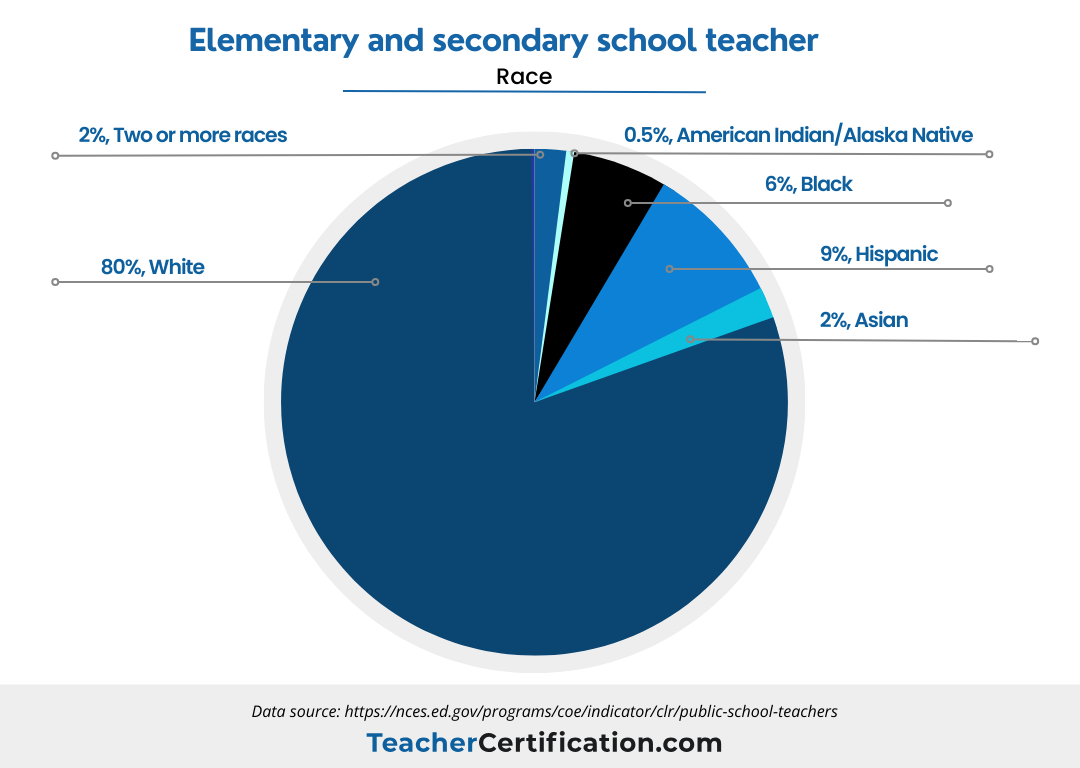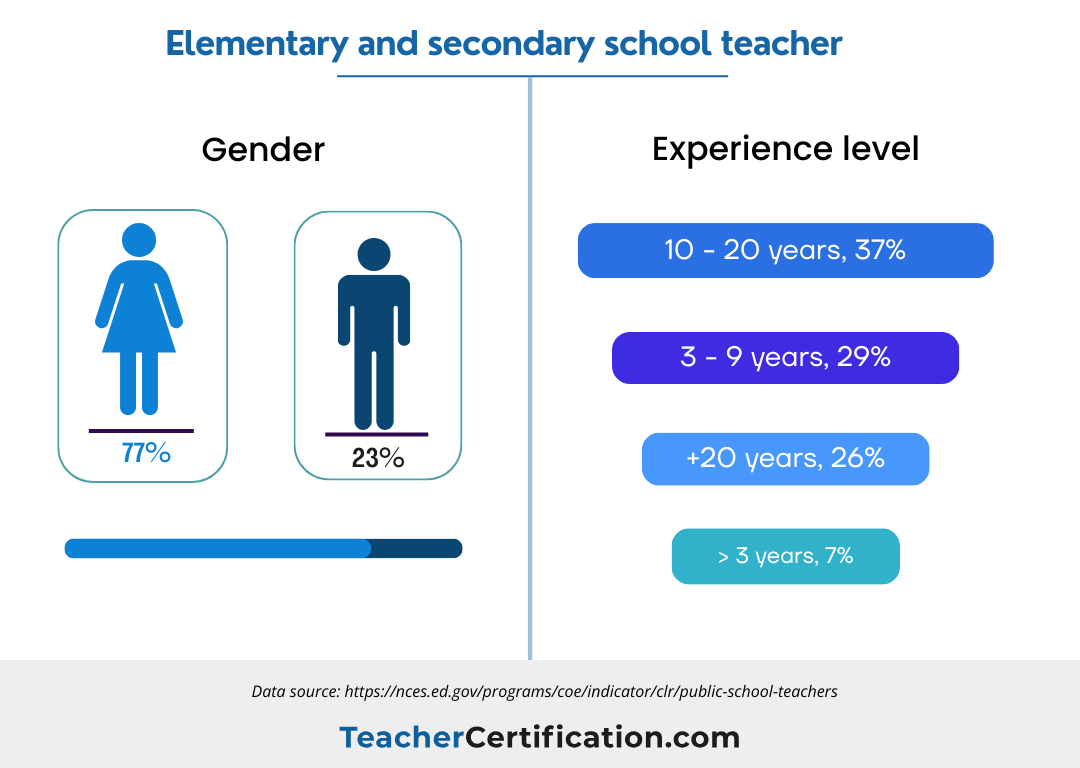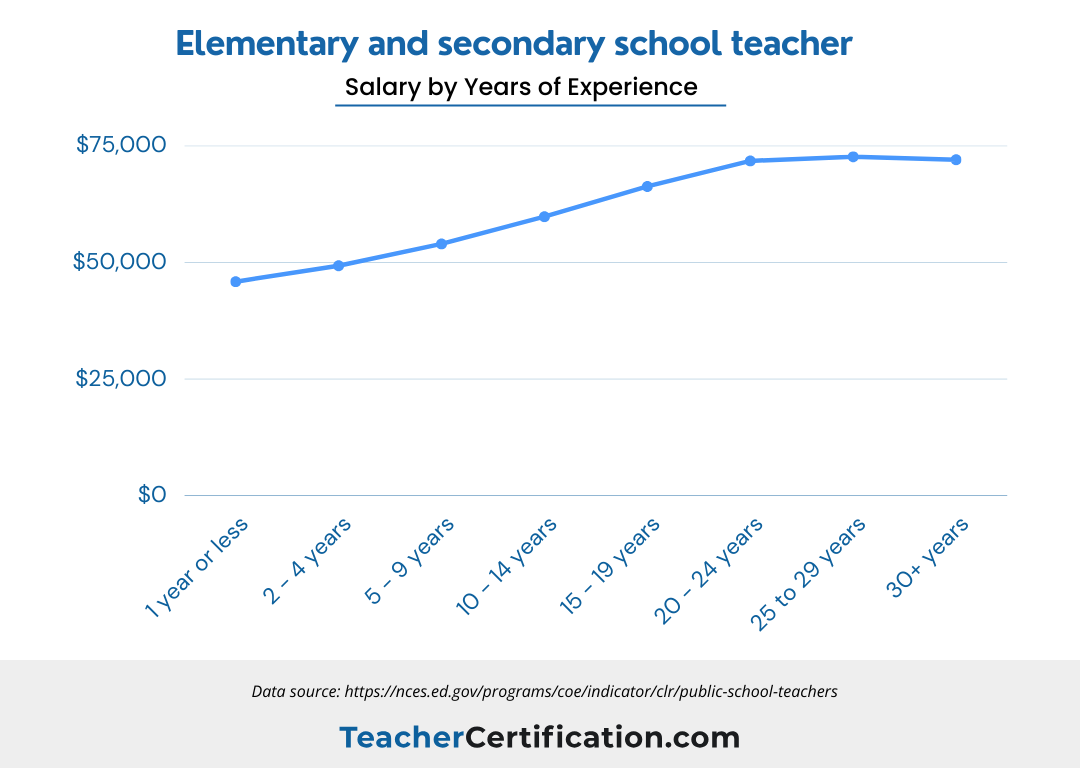Who's teaching our kids? These 4 charts break down K-12 teachers by education level, race, and more

Canva
Who’s teaching our kids? These 4 charts break down K-12 teachers by education level, race, and more
A young female grammar school teacher stands at the front of the class and raises her hand to call on a student
Teachers play a pivotal role in shaping our children’s futures. Many of us may recall a teacher who left an indelible mark on our lives. So, who exactly are the educators currently guiding our elementary and secondary school students?
The National Center for Education Statistics (NCES) published a report in May 2023 detailing the characteristics of public school teachers. This report provides data covering the 2020-2021 school year.
TeacherCertification.com took a close look at this data to identify key trends, their implications, and expert opinions on the findings.
![]()

TeacherCertification.com
More than half of school teachers have earned a master’s, making teachers among the most well-educated professionals
A pie chart showing the education level of elementary and secondary school teachers
Teachers are among the most educated workforce in the United States. Over half (51%) of elementary and secondary school teachers hold master’s degrees, while more than one-third (38%) have received as high as a bachelor’s degree. Only a small minority of teachers (1%) do not have a bachelor’s degree.
Examining the contrast between elementary and secondary school teachers reveals only slight differences. The largest difference is between elementary and secondary school teachers whose highest level of education is a bachelor’s degree, 41% and 35% respectively.
Despite teachers’ advanced education levels, they often don’t receive the salary benefits commonly associated with other highly educated professions. According to the Census Bureau, teachers’ earnings fall short compared to similarly educated individuals in different professions. For example, the average teacher with a bachelor’s degree earned $52,000 for the 2020-21 school year. Meanwhile, the average human resources worker earned a salary of $77,430.

TeacherCertification.com
The teaching profession is predominantly white, presenting potential disadvantages to minority students
pie chart showing racial demographic breakdown of elementary and secondary school teachers
Children in the US will likely be taught by a white teacher. In the 2020-21 academic year, white educators made up 80% of the teaching force in elementary and secondary schools. Hispanic teachers were the next largest group at 9%, followed by Black teachers at 6%.
This means that there are a lot more white teachers than white students. Only 46% of students identified as white. Furthermore, 28% identified as Hispanic, 15% as Black, 5% as Asian, 4% as two or more races, 1% as American Indian/Alaska Native, and less than 1% as Pacific Islander.
The lack of representation can be a disadvantage to minority students. During a webinar at the Brookings Institution, Dr. Seth Gershenson, a professor of public policy at American University, noted that exposure to same-race teachers “increases and improves all sorts of educational outcomes both immediately and in the long run.”
Gershenson enumerated further benefits, noting that students with same-race teachers experience fewer absences and suspensions and achieve better test scores.

TeacherCertification.com
More than two-thirds of teachers are women; nearly 4 in 10 of all teachers have less than a decade of experience
A graphic representation of the Gender Distribution Among Elementary and Secondary School Teachers
The teaching profession is predominantly female. According to NCES data, women have outnumbered men in the teaching field since the 1890s, with records showing that as early as then, 68% of teachers were female. [Please be aware that the data from NCES currently recognizes only two gender categories, not accounting for a broader spectrum of gender identities.]
Fast-forward to the last few years. NCES data shows that throughout the 2020-21 school year, 23% of all elementary and secondary school teachers were male and 77% were female. However, the data looks significantly different when examining elementary and secondary school teachers separately. Among elementary school teachers, 11% were male and 89% were female. In secondary school, 36% were male and 64% were female. This means that more than one-third of secondary school teachers are male compared to just over 1 in 10 elementary teachers.
As this gap persists, different publications have explored its causes and potential consequences. The New York Times asks, “Why Don’t More Men Go Into Teaching?” while the Australian Association for Research in Education asks, “Do We Really Need Male Teachers?“
In an interview for their exploration of male teachers, Rafe Esquith, an author and teacher with 32 years of teaching experience told NYT that he wants to show his students “a guy who lives a different life than a lot of the role models that they see.”
Both the AARE and NYT suggest that to attract and retain more males to the profession, “the underlying factors [such as workload and pay] that deter both men and women from the profession need to be addressed.”

TeacherCertification.com
Salary increases steadily with experience, but after 20 years it plateaus
A line graph showing Salary Scales for Elementary and Secondary School Educators by years of experience
The NCES examined teacher salaries from five different angles – elementary vs. secondary school, years of experience, highest degree received, gender, and race.
The average elementary school teacher receives a salary of $60,500 compared to the average secondary school teacher’s salary of $62,700.
Sorting teachers based on years of experience, we find that teachers make more money the longer they teach. The average teacher with 1 year or less of experience received a salary of $45,900. That figure rises as a teacher’s experience does, eventually plateauing around 20 years of experience. Teachers with 20 to 24, 25 to 29, and 30 or more years of experience all received a salary of ~$72,000.
We see a similar trend when organized by the highest degree received. Teachers who have received their PhDs make an average of $71,300, 36% more than the average of $52,500 that teachers with bachelor’s degrees receive, 6% more than the $67,000 average of teachers with master’s degrees, and 1% more than the average of $70,500 received by those with education specialist degrees or certifications.
In terms of gender, the average male teacher receives a higher salary than the average female teacher — $63,100 to $61,000. So, even though there are more female teachers in both elementary and secondary schools, male teachers typically get paid more than their female counterparts.
Finally, Asian teachers receive the highest average salary at $70,200 while American Indian/Alaska Native teachers receive the lowest average salary at $52,100. The average Hispanic teacher receives a salary of $62,100 and the average white teacher receives $61,600. Both are higher than the salary of the average Black teacher at $59,000.
This story was produced by TeacherCertification.com and reviewed and distributed by Stacker Media.